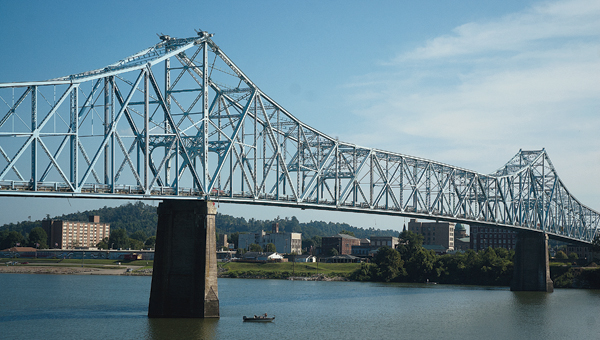Bridge spans time, communities
Published 12:00 am Sunday, August 28, 2011
It wasn’t meant to be here at first.
The structure that has connected the city of Ironton and Lawrence County to Russell, Ky. for approximately the past 90 years was originally designed to span the Mississippi River, connecting St. Paul to Minneapolis, Minn., said Bill Dickens, Ironton’s economic director.
A last-minute cancellation left its designer, the Wisconsin Bridge Company, scrambling to find a city to buy the bridge. Ironton would become that city, after raising more than $700,000 through the sale of bonds to purchase the structure.
Fast-forward to present day and that bridge is still in use, despite a decade-long effort to get it replaced.
Most recently, the Ohio Department of Transportation, which currently owns the bridge, announced that the proposed replacement of the structure would not go to sale on Oct. 6, as planned. Instead the department will look to fund the estimated $85 million project with a public-private partnership. The new bid date is planned for between Oct. 6 and June 2012.
Kathleen Fuller, public information officer for ODOT District 9, explained that the specific plan for the funding of this or other proposed projects has not been established. The prospect of using the private- public partnerships is new to the department. It’s only been allowed beginning in July when new legislation, House Bill 114, was passed, Fuller said.
“We (will) look at every possible option,” Fuller said. “… Everything’s on the table, nothing’s off the table.”
Some of the options may be bonds or leasing through interest payment, Fuller said.
ODOT is likely to face a shortfall soon and needs to explore new ways for funding projects, Fuller said.
Ironton Mayor Rich Blankenship has opposed delaying the bridge. He met with ODOT officials last week to present his argument against the delay.
“Now ODOT says they want to explore alternative funding methods because new legislation allows them to, not directing them to,” Blankenship said during the meeting. “(The Ohio Revised Code) states that local jurisdiction should be considered. (ODOT) is not considering us. With a project so critical and less than seven weeks away from the bid opening, this is not the time to explore. It is time to do what is right and build the bridge.
“Explore on projects that are farther out, not one that is ready and as critical as this one,” the mayor said.
Even with the new delay, Fuller said that the projected completion date of the bridge will likely not change much. That date is roughly three to four years from when construction begins, she said. Weather will be a factor in the construction timeline, she said.
Delays are nothing new
The project to replace the bridge began in 1999, according to a report from ODOT issued in 2007. Besides the latest delay, the bridge was delayed twice before — once in 2004 and again in 2007. In 2007, ODOT accepted bids for the project. Those bids were too high and the department sent the project out to be redesigned, Blankenship said.
At that time, the project was delayed until 2013. Blankenship met with former Governor Ted Strickland to stress the need for the replacement. As a result the bridge was moved up to 2011.
A little history
Before the bridge was constructed, a ferry was the only way to cross the Ohio from Ironton.
Beginning in January 1921, the Ironton Chamber of Commerce began a campaign to raise $700,000 through bond sales to build a bridge to span the Ohio River between Russell, Ky., and Ironton, according to information from by the Lawrence County Historical Society.
By Feb. 28, residents of the two cities as well as others in the Tri-State raised $766,000.
The Ironton-Russell Bridge was the first to be built on the Ohio between Pittsburgh, Pa., and Cincinnati, Dickens said. It was a distinction that did not last long.
Ironton resident Ruth King remembers her mother, Emma Bates, telling her about the bridge dedication ceremony. It was in 1922 and she went to see it. She said school children from Ironton and Russell, Ky., met in the middle of the bridge and sang “Beautiful Ohio,” as officials cut the ribbon.”
“I remember when it was a toll bridge,” King said.
Her friend, Barbara Carson has a toll ticket from that era.
King recalls her uncle would come from West Virginia to Ironton and would have to cross that bridge. With its rattling deck floor, he would exclaim someone should pay him to drive across it rather than him pay the toll to the city.
The wood deck was constructed to have some “give” in it and the rattling of the boards was what people heard as they drove along.
“It rattled and as a schoolchild I was scared to death,” King recalled. “I was sure we’d fall in the river.”
Besides some adjustments, the bridge looks like it did when it was built, Dickens said. The structure originally had spears coming from the four highest points of the bridge, but those were removed when it was painted in 1949.
The wooden planks covered the bridge’s floor until as late as 1946.
In 1959, the Ohio Bridge Commission purchased the bridge and stockowners got back only what they paid into the project, Dickens said. The bridge commission continued to operate the structure as a toll bridge until the 1970s.
The bridge was later transferred to the control of the Ohio Department of Transportation, which continues to maintain it.
A lasting impact
These days the bridge plays a vital role in the economy of the community, Dickens said.
“There’s an economic impact because commerce flows both ways,” he said. “It would be a negative impact if the bridge is closed.”
The bridge affects not only businesses in Ironton, but also those in Russell, Ky.
“We need to keep the bridge safe and open as long as we possibly can because our downtown businesses depend on traffic from Ironton and vice-versa,” Russell Mayor William Hopkins said.
Safety is key
Despite the bridge’s age, Fuller said the bridge is safe. It undergoes various evaluations during the year and is also monitored electronically, she said.
ODOT’s plan is to keep the bridge open and functioning as long as possible, but if it becomes unsafe, the department will close it, she said.
During the recent meeting with ODOT officials about the fate of the proposed replacement project, Blankenship cited a report from ODOT from September 2007 that called the bridge “structurally deficient” and “functionally obsolete.”
The mayor has also been concerned recently about noises coming from the bridge following last week’s earthquake in Virginia.
Fuller said the bridge was inspected Tuesday evening following the tremor and it is still safe.
“They didn’t find anything,” Fuller said. “Preliminary (results) were that there was no damage from the earthquake.”
Even with ODOT’s assurances that the bridge is safe, concern over the structure abounds.
Hopkins said that the majority of the people that he talks about the bridge with are concerned about its safety.
Dickens agreed.
“During the past several years, a number of persons have expressed to me that they refuse to cross the bridge because of safety concerns and always use the Ashland bridge,” Dickens said.
Hopkins said that, though the delay may not seem long, given that the bridge already is shut down when the temperatures get too cold in the winter, the delay is concerning.
“All the people in Russell are concerned by any delay,” Hopkins said.
He added that the City of Russell and the Commonwealth of Kentucky have no input on when the bridge will be constructed, but the city is affected by it. The new bridge will affect construction of a viaduct in Russell, Hopkins said. The Commonwealth of Kentucky will install the viaduct but the state is waiting until the construction of the bridge.
“I’m not bitter or upset about it but it’s the fact that they need to get the schedule going and quit talking about this finance thing and go ahead,” Hopkins said.




